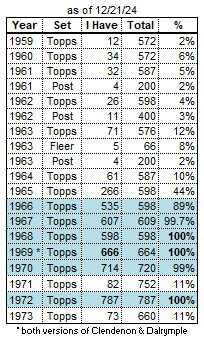More Classic Crew Cuts (Yankees edition):
First we have
Dick Howser (#411). Dick was a serviceable shortstop, and was the regular SS for Kansas City in 1961, and Cleveland in 1964. (In 1964, he led the American League with 735 plate appearances.) He was acquired by the Yankees in December 1966. Howser was just one of many players who played for the Kansas City Athletics (affectionately known as the Yankees farm team) prior to joining the Yankees. He just made a stop in Cleveland along the way. Dick was primarily used as a pinch-hitter in 1967, with a few appearances at 2B and 3B. He wrapped up his career in 1968 as a Yankees pinch-hitter and backup 2nd baseman.
Dick is probably better known for his managing career, where he managed the Yankees in 1980 and the Kansas City Royals from 1981 to 1986.
.jpg)
.jpg) Charley Smith (#257)
Charley Smith (#257) had the twin misfortunes to:
1) Follow long-time Cardinals 3rd baseman Ken Boyer in St. Louis
2) Be the player for whom Roger Maris was traded
Charley started his career with the Dodgers, and made stops with the Phillies, White Sox, Mets, and Cardinals before landing at Yankee Stadium.
Like Dick Howser's card, Charley Smith's card tells us that the player will be "given a chance to win a regular job" in 1967, but for some reason, Charley's card specifies the shortstop position. Smith rarely played shortstop in his career, and played exclusively at 3B from 1965 to 1968. He was the Yankees regular 3rd baseman in 1967, but lost the starting job in 1968 to rookie Bobby Cox (the current Braves manager).
After 2 years with the Yankees, Charley finished his career in 1969 with 2 pinch-hitting appearances for the Cubs.
.jpg)
.jpg)
This is the last installment in my Crew Cut series. I'm ending it one post earlier than planned, because I've realized that the labels are more accurate if unrelated cards aren't combined in the same post. (Darold Knowles and Bob Duliba will just have to wait their turn.)
Oh... here's the wildcard crewcut:

Oops! With a name like Buzz Nutter, you would think he
had to have a crew cut! Oh well, here's a compensatory pick:

.jpg)
.jpg)

.jpg)
.jpg)
.jpg)
.jpg)
.jpg)
.jpg)
.jpg)
.jpg)
.jpg)
.jpg)
.jpg)
.jpg)
.jpg)
.jpg)
.jpg)
.jpg)










.jpg)
.jpg)
.jpg)
.jpg)
.jpg)
.JPG)
+(f).jpg)
+(r).jpg)
.jpg)
.jpg)
.jpg)
.jpg)
.jpg)
.jpg)
.jpg)
.jpg)
.jpg)
.jpg)
.jpg)
.jpg)
.jpg)
.jpg)
.jpg)
.jpg)




.jpg)
.jpg)

















